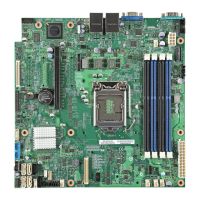Functional Architecture Intel® Server Board S1200V3RP TPS
Revision 1.2
Transmit/Receive activity
3.4.7.1 MAC Address Definition
Each Intel
®
Server Board S1200V3RPL, S1200RPO, or S1200RPM has the following MAC
addresses assigned to it at the factory:
NIC 1 MAC address (for OS usage)
NIC 2 MAC address – Assigned the NIC 1 MAC address +1 (for OS usage)
Integrated BMC LAN Channel MAC address – Assigned the NIC 1 MAC address +2
Intel
®
Remote Management Module 4 dedicated NIC MAC address – Assigned the NIC
1 MAC address +3
Each Intel
®
Server Board S1200V3RPS has the following MAC addresses assigned to it at the
factory:
NIC 1 MAC address
NIC 2 MAC address – Assigned the NIC 1 MAC address +1
Integrated BMC LAN Channel MAC address – Assigned the NIC 1 MAC address +2
3.4.8 Enhanced Power Management
The Intel
®
C220 series chipset’s power management functions include enhanced clock control
and various low-power (suspend) states (for example, Suspend-to-RAM and Suspend-to-Disk).
A hardware-based thermal management circuit permits software-independent entrance to low-
power states. The Intel
®
C220 series chipset contains full support for the Advanced
Configuration and Power Interface (ACPI) Specification, Revision 4.0a.
3.4.9 Serial Ports
The server board provides two serial ports: an external DB9 serial port connector and an
internal DH-10 serial header.
The rear DB9 Serial A port is a fully functional serial port that can support any standard serial
device.
The Serial B port is an optional port accessed through a nine-pin internal DH-10 header (J9A2).
You can use a standard DH-10 to DB9 cable to direct serial A port to the rear of a chassis.
3.4.10 KVM/Serial Over LAN (SOL) Function
These functions support redirection of keyboard, mouse, and text screen to a terminal window
on a remote console. The keyboard, mouse, and text redirection enables the control of the client

